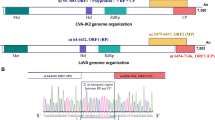Abstract
In 2020, lilac trees showing virus-like symptoms such as leaf necrosis and chlorosis were observed in Korea. After RT-PCR detection with specific primer sets designed based on previously reported nucleotide sequences of viruses in lilac, the agent was identified as ligustrum virus A (LVA). The complete genome of the virus was sequenced and used for phylogenetic analysis. The genome of this novel strain of LVA, LVA-SNU, is 8524 nucleotides long, excluding the poly(A) tail, and shares the highest nucleotide sequence identity (77.28%) with LVA-Sob, which was detected in a plant of the same species, Syringa oblata, in China, whereas LVA-Sob shares higher sequence identity (97.89%) with LVA-SK, which has been detected in host plants of various species.

Similar content being viewed by others
References
Hongxia C, Gaoming J, Shuying Z (2004) The distribution, origin and evolution of Syringa. Zhiwu Yanjiu 24:141–145
Su G, Cao Y, Li C, Yu X, Gao X, Tu P, Chai X (2015) Phytochemical and pharmacological progress on the genus Syringa. Chem Cent J 9:2
Igori D, Lim S, Zhao F, Baek D, Park JM, Cho HS, Kim HS, Kwon S-Y, Moon JS (2016) The complete sequence and genome organization of Ligustrum virus A, a novel Carlavirus. Arch Virol 161:3593–3596
Sastry KS, Mandal B, Hammond J, Scott SW, Briddon RW (2019) Syringa spp. (Lilac). Encyclopedia of plant viruses and viroids. Springer India, New Delhi, pp 2518–2522
James D, Varga A, Leippi L, Godkin S, Masters C (2010) Sequence analysis of RNA 2 and RNA 3 of lilac leaf chlorosis virus: a putative new member of the genus Ilarvirus. Arch Virol 155:993–998
Scott S, Ge X (1995) The complete nucleotide sequence of the RNA 3 of lilac ring mottle ilarvirus. J Gen Virol 76:1801–1806
Novák J, Lanzová J (1977) Purification and properties of arabis mosaic and tomato bushy stunt viruses isolated from lilac (Syringa vulgaris L.). Biol Plant 19:264–271
King AM, Adams MJ, Carstens EB, Lefkowitz EJ (2012) Virus taxonomy: classification and nomenclature of viruses. Virus taxonomy: classification and nomenclature of viruses, pp 1327–1327
Kumar S, Stecher G, Li M, Knyaz C, Tamura K (2018) MEGA X: molecular evolutionary genetics analysis across computing platforms. Mol Biol Evol 35:1547
Martin DP, Varsani A, Roumagnac P, Botha G, Maslamoney S, Schwab T, Kelz Z, Kumar V, Murrell B (2021) RDP5: a computer program for analyzing recombination in, and removing signals of recombination from, nucleotide sequence datasets. Virus Evol 7:veaa087
Fujita N, Komatsu K, Ayukawa Y, Matsuo Y, Hashimoto M, Netsu O, Teraoka T, Yamaji Y, Namba S, Arie T (2018) N-terminal region of cysteine‐rich protein (CRP) in carlaviruses is involved in the determination of symptom types. Mol Plant Pathol 19:180–190
Acknowledgements
This research was supported in part by grants from the Korea Institute of Planning and Evaluation for Technology in Food, Agriculture and Forestry (320037-05-1-HD020), funded by Ministry of Agriculture, Food and Rural Affairs and the Agenda Program (no. PJ01488703), the Rural Development Administration (RDA), Republic of Korea. JO and SJ were supported by research fellowships from the Brain Korea 21 Plus Project.
Author information
Authors and Affiliations
Corresponding author
Ethics declarations
Conflict of interest
The authors declare no conflicts of interest.
Ethical approval
This article does not contain any studies involving human participants or animals.
Additional information
Communicated by Stephen John Wylie.
Publisher’s Note
Springer Nature remains neutral with regard to jurisdictional claims in published maps and institutional affiliations.
Electronic supplementary material
Below is the link to the electronic supplementary material.
Rights and permissions
About this article
Cite this article
Oh, J., Yu, J., Jang, S. et al. Identification of a new strain of ligustrum virus A causing leaf necrosis and chlorosis symptoms in Syringa oblata var. dilatata (Nakai) Rehder. Arch Virol 167, 1487–1490 (2022). https://doi.org/10.1007/s00705-022-05439-1
Received:
Accepted:
Published:
Issue Date:
DOI: https://doi.org/10.1007/s00705-022-05439-1




